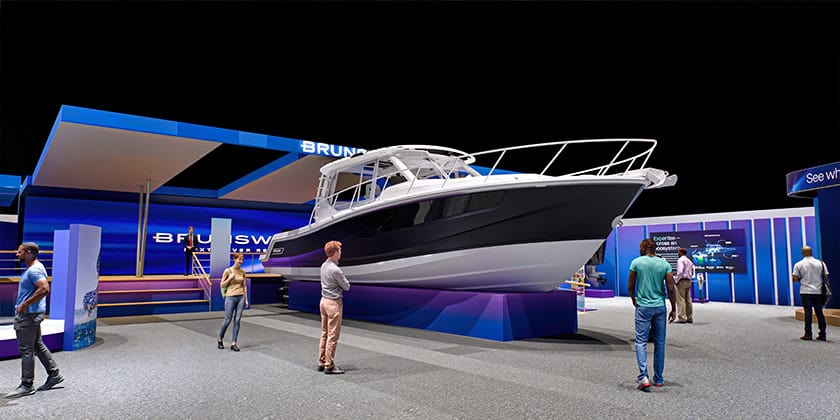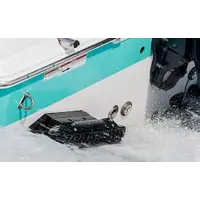Years ago, after graduating from college, I landed a part-time gig introducing new boat owners to their vessels. My responsibilities included going over the basics like explaining the boat's systems and practicing docking. Despite my efforts to be thorough, I often felt that these short sessions left new owners with a false sense of confidence rather than genuine competence. Many of them could have benefited from more guidance.
Fast forward to today, Brunswick Corporation is moving forward with its Autonomous, Connected, Electrified, Shared (ACES) strategy by introducing a Boating Intelligence initiative that leverages AI to enhance the boating experience.
Boating Intelligence doesn't mean that Brunswick-built boats will start piloting themselves just yet. Instead, it focuses on using AI in various ways to make boating more inclusive and user-friendly. This includes facilitating interaction between the boat and the captain, providing timely data, and helping users improve their skills.
Think of Boating Intelligence as a more advanced version of popular AI assistants like Amazon's Alexa or Apple's Siri. While drawing parallels, Brunswick's Boating Intelligence Design Lab aims to develop user-centric solutions to address challenges in boating.
The ACES strategy was first introduced by Brunswick in 2019 to create a unified approach to incorporating new technologies across its brands. In mid-2024, Brunswick took a step further by unveiling Boating Intelligence and relaunching the supporting Design Lab, which was originally known as the I-Jet Lab.
Jeff Reifsnyder, Brunswick's director of advanced technologies and head of the Boating Intelligence Design Lab, emphasizes the significance of AI in this initiative. He states, "We wouldn't call it Boating Intelligence if AI wasn't involved."
Connected-boat models, with cloud-based systems monitoring onboard functions, have been popular for years. Boating Intelligence will build upon this concept by integrating onboard AI tools such as computer vision, machine learning, language models, and virtual assistants.

For instance, while connected boats may log the daily operation time of a bilge pump, Boating Intelligence can analyze this data to detect anomalies and provide owners with DIY solutions or information about nearby service centers through virtual assistants.
Moreover, Reifsnyder highlights that Boating Intelligence aims to identify challenges in boating and utilize modern computing tools to enhance the user experience. Key objectives include transforming boats into interactive partners, offering real-time information, and guiding users through mastering the boating experience.
Boating Intelligence is envisioned as a supportive tool that delivers relevant information to users wherever they are on the boat. Reifsnyder likens its role to that of an executive officer on a military vessel, bridging communication between the crew and the boat to fulfill the captain's commands.
One potential future application of Boating Intelligence could involve assisting owners in interpreting sonar or radar data to better comprehend these technologies and enhance their proficiency.
The Boating Intelligence Design Lab, situated at the University of Illinois Research Park, serves as a space to explore advanced technologies outside of a production environment. Unlike traditional approaches of developing technologies first, this lab prioritizes understanding boaters' challenges before devising the most suitable tools and technologies to address them.
Autonomous operations represent a significant focus for Brunswick. At the 2024 Consumer Electronics Show, Brunswick showcased a self-docking Boston Whaler 405 Conquest equipped with parking assistance similar to automobiles and the ability to navigate to specified locations.
Reifsnyder explains that achieving autonomous operations involves deploying advanced technologies like virtual path planners to chart the boat's course and computer vision for the vessel to "see" its surroundings using cameras and sensors. Brunswick's roadmap includes developing autonomy and advanced driver-assistance systems, including features like object detection and avoidance during cruising.
Following a similar autonomy classification as in the automotive industry, Reifsnyder mentions that Brunswick is aiming for Level 3 autonomy, which involves significant software development alongside hardware and product enhancements.
While Boating Intelligence is currently tailored towards beginner and intermediate boaters to address their pain points, the long-term vision includes providing tools for boaters of all skill levels. Reifsnyder acknowledges that while some individuals may desire full autonomy, many experienced boaters prefer systems that enhance rather than replace the boating experience.
If Brunswick manages to strike the right balance, Boating Intelligence tools could streamline the learning curve, enhance safety, attract novice and intermediate boaters, and expand the boating market. However, potential challenges include alienating seasoned boaters and increasing costs and complexity.
Reflecting on past experiences, the benefits of Boating Intelligence are evident. Auto-docking features and onboard virtual assistants would have been invaluable when introducing new boat owners to their vessels and preventing mishaps like unintentional collisions with docks.
Smarter Interfaces
While many advancements from Brunswick's Boating Intelligence may focus on behind-the-scenes improvements, the user experience will also see notable enhancements. Boaters can anticipate interacting with these innovations through a Simrad multifunction display or the Simrad app on wireless devices.








